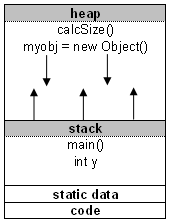What is heap and stack?
What are the memory segments?
The distinction between stack and heap relates to programming. When you look at your computer memory, it is organized into three segments:- text (code) segment
- stack segment
- heap segment

What is stack?
The two sections other from the code segment in the memory are used for data. The stack is the section of memory that is allocated for automatic variables within functions.Data is stored in stack using the Last In First Out (LIFO) method. This means that storage in the memory is allocated and deallocated at only one end of the memory called the top of the stack. Stack is a section of memory and its associated registers that is used for temporary storage of information in which the most recently stored item is the first to be retrieved.
What is heap?
On the other hand, heap is an area of memory used for dynamic memory allocation. Blocks of memory are allocated and freed in this case in an arbitrary order. The pattern of allocation and size of blocks is not known until run time. Heap is usually being used by a program for many different purposes.The stack is much faster than the heap but also smaller and more expensive.
Heap and stack from programming perspective
Most object-oriented languages have some defined structure, and some come with so-called main() function. When a program begins running, the system calls the function main() which marks the entry point of the program. For example every C, C++, or C# program must have one function named main(). No other function in the program can be called main(). Before we start explaining, let's take a look at the following example:int x; /* static stack storage */
void main() {
int y; /* dynamic stack storage */
char str; /* dynamic stack storage */
str = malloc(50); /* allocates 50 bytes of dynamic heap storage */
size = calcSize(10); /* dynamic heap storage */
When a program begins executing in the main() function, all variables declared within main() will be stored on the stack.If the main() function calls another function in the program, for example calcSize(), additional storage will be allocated for the variables in calcSize(). This storage will be allocated in the heap memory segment.
Notice that the parameters passed by main() to calcSize() are also stored on the stack. If the calcSize() function calls to any additional functions, more space would be allocated at the heap again.
When the calcSize() function returns the value, the space for its local variables at heap is then deallocated and heap clears to be available for other functions.
The memory allocated in the heap area is used and reused during program execution.
It should be noted that memory allocated in heap will contain garbage values left over from previous usage.
Memory space for objects is always allocated in heap. Objects are placed on the heap.
Built-in datatypes like int, double, float and parameters to methods are allocated on the stack.
Even though objects are held on heap, references to them are also variables and they are placed on stack.
The stack segment provides more stable storage of data for a program. The memory allocated in the stack remains in existence for the duration of a program. This is good for global and static variables. Therefore, global variables and static variables are allocated on the stack.
No comments:
Post a Comment